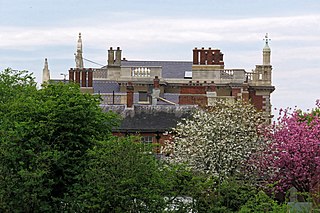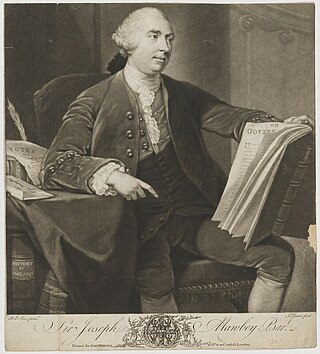Related Research Articles
There have been ten baronetcies created for persons with the surname Browne, six in the Baronetage of Great Britain, three in the Baronetage of Ireland and one in the Baronetage of Nova Scotia. Only one creation is extant as of 2010. Three of the creations were for members of the Browne family headed by the Viscount Montagu.
There have been six Baronetcies created for persons with the surname Brown, one in the Baronetage of Nova Scotia, one in the Baronetage of England, two in the Baronetage of Great Britain and two in the Baronetage of the United Kingdom. Two creations are extant as of 2010.

The Antrobus Baronetcy, of Antrobus in the County Palatine of Chester, is a title in the Baronetage of the United Kingdom.
There have been five baronetcies created for people with the surname Napier, three in the Baronetage of England, one in the Baronetage of Nova Scotia and one in the Baronetage of the United Kingdom. As of 2014 two of the creations are extant.

There have been three baronetcies created for persons with the surname Burdett, two in the Baronetage of England and one in the Baronetage of Ireland. As of 2008, two of the creations are extant while one is dormant.
There have been nine baronetcies created for persons with the surname Lloyd, three in the Baronetage of England, three in the Baronetage of Great Britain and three in the Baronetage of the United Kingdom. Two of the creations are extant as of 2010.

There have been two baronetcies created for people with the surname Barrington. As of 2014 one creation is extant.
There have been four baronetcies created for persons with the surname Butler; two in the Baronetage of Ireland and two in the Baronetage of the United Kingdom. As of 2014 two of the creations are extant.

The Macgregor Baronetcy, of Savile Row in the County of Middlesex, is a title in the Baronetage of the United Kingdom. It was created on 17 March 1828 for Patrick Macgregor, Serjeant-Surgeon to King George IV. Charles Reginald Macgregor (1847–1902), second son of the third Baronet, was a Brigadier-General in the Army.
There have been three baronetcies created for people with the surname Riddell, one in the Baronetage of Nova Scotia, one in the Baronetage of Great Britain and one in the Baronetage of the United Kingdom. As of 2014 one creation is extant.

The Lighton Baronetcy, of Merville in Dublin, is a title in the Baronetage of Ireland. It was created on 1 March 1791 for the Dublin-based banker and politician Thomas Lighton. Sir Thomas was an Ulsterman, being a native of Strabane in the west of County Tyrone. He had made his fortune with the East India Company in India. In the early 1790s he had No. 22 St. Stephen's Green North built as his Dublin residence. This house is now The Cliff Townhouse, an upmarket boutique hotel, bar and restaurant. He sat as a Member of the Irish Parliament for Tuam from 1790 to 1797 and Carlingford from 1798 to 1800. His partner in the banking firm of Lighton, Needham & Shaw, Robert Shaw, was created a baronet in 1821.
There have been two baronetcies created for persons with the surname Darell, one in the Baronetage of England and one in the Baronetage of Great Britain. As of 2014 one creation is extant.
There have been four baronetcies created for people with the surname Innes, three in the Baronetage of Nova Scotia and one in the Baronetage of the United Kingdom. Three of the creations are extant as of 2010.
There have been two Cook Baronetcies. This first was created in the Baronetage of England in 1663 and went extinct in 1708. The second was created in the Baronetage of the United Kingdom in the 19th century and is extant.

The Watson, later Kay Baronetcy, of East Sheen in the County of Surrey, was a title in the Baronetage of the United Kingdom. It was created on 5 December 1803 for the merchant and soldier Brook Watson, with remainder failing male issue of his own to his great-nephews William Kay and Brook Kay and the male issue of their bodies. Watson died unmarried and was succeeded according to the special remainder by his great-nephew William Kay, the third Baronet. The title became extinct in 1918, when the sixth baronet was killed in action on the Western Front.
John Ivatt Briscoe was an English Whig and later Liberal politician who sat in the House of Commons from 1857 to 1870.

There have been two baronetcies created for persons with the surname Meux, one in the Baronetage of England and one in the Baronetage of the United Kingdom. Both are extinct.

There have been two baronetcies created for persons with the surname More, both in the Baronetage of England. Both creations are extinct.

Sir Joseph Mawbey, 1st Baronet was an English distiller and politician who sat in the British House of Commons between 1761 and 1790. He was a political supporter of John Wilkes.

Botleys Mansion is a Palladian mansion house in the south of Chertsey, Surrey, England, just south of St Peter's Hospital. The house was built in the 1760s by builders funded by Joseph Mawbey and to designs by Kenton Couse. The elevated site once bore a 14th-century manor house seized along with all the other manors of Chertsey from Chertsey Abbey, a very rich abbey, under Henry VIII's Dissolution of the Monasteries and today much of its land is owned by two hospitals, one public, one private and the local council authority. The remaining mansion and the near park surrounding were used for some decades as a colony hospital and as a private care home. The building is owned and used by a wedding venues company.